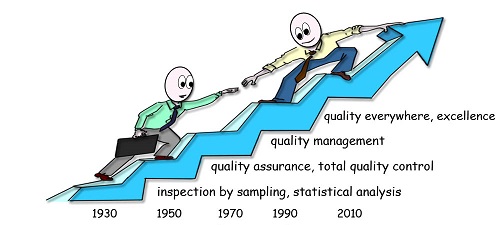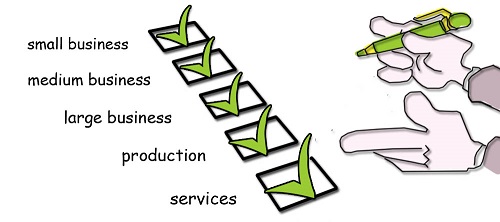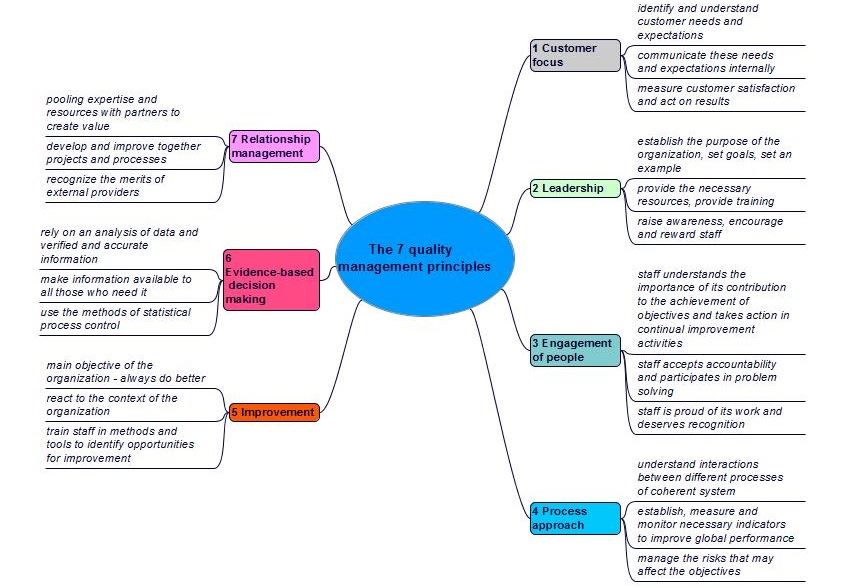1 Quality approach T 21
1.1 Background
Quality standards' evolution
Other aerospace proverbs and quotes

Quality management systemset of processes allowing the achievement of the quality objectives (see also ISO 9000, 3.5.4) (QMSQuality Management System) standards emerged in the 1980s:
- 1987: ISO 9000 first edition: ISO 9001; ISO 9002; ISO 9003; ISO 9004
- 1994: ISO 9000 revision n° 1: ISO 9001; ISO 9002; ISO 9003; ISO 9004 – more understandable, customer focus better determined, preventive actions added
- 2000: ISO 9000 revision n° 2: ISO 9000; ISO 9001; ISO 9004 – simplified structure (8 clauses), priority to process approach and customer satisfaction
- 2008: third revision (fourth edition of ISO 9001): clarification of the requirements (no new requirement), better alignment with ISO 14 001
- 2015: fourth revision, new structure (high level), added risk-based thinking, performance becomes a priority, lightweight documentation
Aerospace references appeared in the 1990s:
- RG Aéro 000 83 (1994) (Qualifas Association - Supply Quality for the French Aerospace and Space Industries)
- ARD9000 (1996) - Aerospace Basic Quality System Standard
- D1-9000 (1997) - Advanced Quality System (Boeing)
- AS9000 (1997) - Aerospace Basic Quality System Standard
- AS9100 (1999) - Quality management systems requirements and Quality systems
- EN 9100 (2003) - Requirements (based on ISO 9001: 2000) and quality system. Model for quality assurance in design, development, production, installation and operation (based on ISO 9001: 1994)
- EN 9100 (2010): Aerospace Series - Quality Management Systems - Requirements for Aeronautics, Space and Defense Organizations
- AS9100D (2016) - Quality Management Systems - Requirements for Aviation, Space, and Defense Organizations
The ISO 9000 standards have appeared in:
- 1987: first edition
- 1994: first revision, more understandable, customer focus better determined, preventive actions added
- 2000: second revision, simplified structure (8 clauses), priority to process approach and customer satisfaction
- 2008: third revision, clarification of the requirements (no new requirement), better alignment with ISO 14001
- 2015: fourth revision, new structure (high level), added risk-based thinking, performance becomes a priority, lightweight documentation
The first version of the AS9100 standard was published in 1999 under the direction of SAE (Society of Automotive Engineers) and AECMA (European Association of Aerospace Material Manufacturers) now ASD - AeroSpace and Defense Industries Association of Europe. The AS9100 standard (EN 9100 for Europe, first edition in 2003) is globally accepted by all participants in the aerospace industry.
The role of the International Aerospace Quality Group (IAQG) and the European Aerospace Quality Group (EAQG) was essential to replacing existing standards in different countries with a single standard.
The latest version of the standard (AS9100D, version 2016) is published by the SAE.
1.2 Scope
Scope of the QMS, when certain requirements cannot be applied

The AS9100D standard applies to any civilian or military company (regardless of size) that manufactures aerospace productsany outcome of a process or activity (see also ISO 9000, 3.7.6) in the area of design, development, production and related services. Companies mainly supplying maintenance services use the EN 9110 standard and those in distribution use the EN 9120 standard.
This allows a unique certification recognized worldwide for any company related to aerospace production. The requirements of the AS9100D and the specific requirementsexplicit or implicit need or expectation (see also ISO 9000, 3.6.4) of customersanyone who receives a product (see also ISO 9000, 3.2.4) are the basis of any management systemset of processes allowing objectives to be achieved (see also ISO 9000, 3.5.3) for manufacturers in the aerospace field.
Certain requirementsexplicit or implicit need or expectation (see also ISO 9000, 3.6.4) of the standard may not apply to the aerospace quality management systemset of processes allowing the achievement of the quality objectives (see also ISO 9000, 3.5.4) (see sub-clause 4.3).
1.3 Principles and steps
Quality management principles, preparation and implementation, Deming cycle

Quality is anything that can be improved. Masaaki Imai
The qualityaptitude to fulfill requirements (see also ISO 9000, 3.6.2) approach is a state of mind which starts with top managementgroup or persons in charge of the organizational control at the highest level (see also ISO 9000, 3.1.1) as a priority strategic decision and extends to all employees. Top managementgroup or persons in charge of the organizational control at the highest level (see also ISO 9000, 3.1.1) develops a quality policystatement by top management allowing the establishment of quality objectives (see also ISO 9000, 3.5.9) which determines the quality objectivesquality-related, measurable goal that must be achieved (see also ISO 9000, 3.7.2), themselves applicable to all activities. The tool used to achieve the objectives is the aerospace quality management systemset of processes allowing the achievement of the quality objectives (see also ISO 9000, 3.5.4). Prevention is a key concept of quality management systemsset of processes allowing the achievement of the quality objectives (see also ISO 9000, 3.5.4).
The aerospace quality management systemset of processes allowing the achievement of the quality objectives (see also ISO 9000, 3.5.4) includes three distinct and interrelated steps:
- the process approach
- risk-based thinking
- continual improvement
The purpose of an aeropsace quality management systemset of processes allowing the achievement of the quality objectives (see also ISO 9000, 3.5.4) is to increase the satisfaction of customersanyone who receives a product (see also ISO 9000, 3.2.4) (both external and internal) by meeting their needs and expectations through continual improvement of the effectivenesscapacity to perform planned activities with minimum effort (see also ISO 9000, 3.7.11) of the processesactivities that transform inputs into outputs (see also ISO 9000, 3.4.1).
Qualityaptitude to fulfill requirements (see also ISO 9000, 3.6.2) is almost free when customersanyone who receives a product (see also ISO 9000, 3.2.4) are satisfied: they remain loyal to us. It’s only when the customeranyone who receives a product (see also ISO 9000, 3.2.4) is not fully satisfied that qualityaptitude to fulfill requirements (see also ISO 9000, 3.6.2) becomes very expensive to us: sooner or later the customeranyone who receives a product (see also ISO 9000, 3.2.4) will go to a competitor.
Quality remains long after the price has been forgotten
The seven quality managementactivities allowing the control of an organization with regard to quality (see also ISO 9000, 3.3.4) principles (cf. figure 1-1) will help us achieve sustained success (cf. ISO 9000: 2015, sub-clause 2.3). Previously there were eight but now the system approachmanagement of a set of interacting processes to be able to achieve organizational objectives (see also ISO 9004, Annex B.6) is integrated into the process approachmanagement by the processes to better satisfy customers, improve the effectiveness of all processes and increase global efficiency (see also ISO 9001, 03).

Figure 1-1. The 7 quality management principles
A well-prepared approach is halfway to success
The approach to implementing an aerospace quality management systemset of processes allowing the achievement of the quality objectives (see also ISO 9000, 3.5.4) (AQMSAerospace Quality Management System) starts with preparation. An example is shown in figure 1-2.
.gif)
Figure 1-2. AQMS preparation
Step 1 involves identifying the needs and expectations (requirements) of stakeholdersperson, group or organization that can affect or be affected by a company (see also ISO 26000, 2.20):
- staff
- customers, distributors and consumers
- competitors
- shareholders and investors
- external providers (suppliers, subcontractors and partners)
- organizations and branch associations
- statutory and regulatory authorities
The involvement of top managementgroup or persons in charge of the organizational control at the highest level (see also ISO 9000, 3.1.1) at its highest level is truly indispensable. The advice of a consultant is often solicited. A mandatory prerequisite is the ISO 9001 version 2015 certification. An external certification body is chosen (it may be different from that for ISO 9001).
One of the key questions which comes up quickly (step 2) is the need for this decision. If this is not really necessary or if the estimated costs of the certification approach exceed the available resources, it is better to dismiss idea immediately.
The ISO 9000 family of standards will stop you making promises you can't fulfil and help you keep those you can. David Hoyle
The benefits of implementing a quality management systemset of processes allowing the achievement of the quality objectives (see also ISO 9000, 3.5.4) are often:
- an improved image of the organization
- being one step ahead of the competition
- enhanced customer satisfaction
- better economic results
- increased daily efficiency
- staff who are aware, consulted, motivated and proud
- high level of risk control
- reduced insurance costs
- profitable engagement for all
- best practices are valorized
- formalization of knowledge
- process control
- updated legal obligations
The benefits of the certification of a quality management systemset of processes allowing the achievement of the quality objectives (see also ISO 9000, 3.5.4) are often:
- new customers
- increased market share
- an increase in sales
- better financial performance
More than one and a half million businesses worldwide can not be wrong!
Airbus, one of the world leaders in aeronautics, has implemented the AS9100 to guarantee the quality of its products and improve aviation safety. The standardization of procedures and the establishment of a quality culture have made it possible to reduce manufacturing defects and improve aircraft reliability.
Airbus has recorded a significant improvement in product quality, demonstrating the company's commitment to aviation safety and the positive impact of the AS9100 on financial performance.
The internalization of the spirit of the principles and requirementsexplicit or implicit need or expectation (see also ISO 9000, 3.6.4) of an ISO standard significantly improves the overall performance of your business, especially when it is not considered as a constraint.
The third step shall determine whether this approach receives the approval of the staff. A communication campaign is launched in-house on the objectives of an aerospace quality management systemset of processes allowing the achievement of the quality objectives (see also ISO 9000, 3.5.4) (AQMSAerospace Quality Management System). The staff is aware and understands that, without their participation, the project cannot succeed.
Have confidence: success will come with the involvement and effort of all!
The vision (what we want to be), the mission (why we exist) and the business plan of the company are determined. The following step (4) includes adding specific aerospace requirements in the quality policy. If you do not have a copy of the AS9100D standard, now is the time to get it (see sub-clause 2.1 of the present course).
Planning is the last step (5) of the project preparation for obtaining AS9100D certification. A reasonable period is between 5 to 8 months (each company is unique and specific). The financial resources and staff are confirmed by top managementgroup or persons in charge of the organizational control at the highest level (see also ISO 9000, 3.1.1). A managementrepresentative (usually it is the quality manager) is appointed as project leader. Top management commitment is formalized in a documentany support allowing the treatment of information (see also ISO 9000, 3.8.5) communicated to all staff.
The establishment and implementation of an aerospace quality management systemset of processes allowing the achievement of the quality objectives (see also ISO 9000, 3.5.4) are shown in figure 1-3.
.jpg)
Figure 1-3. QMS implementation
Step 1 aims to identify and determine the specific aeropsace requirementsexplicit or implicit need or expectation (see also ISO 9000, 3.6.4) in processes and documented informationany support allowing the treatment of information. New documented informationany support allowing the treatment of information is created (FMEA, quality plan). The quality manualdocument specifying the general measures taken by an organization to obtain conforming products or services (see also ISO 9000, 3.8.8) is updated.
In step 2 the new necessary resources to achieve the quality objectivesquality-related, measurable goal that must be achieved (see also ISO 9000, 3.7.2) are set. Planning tasks, responsibilitiescapacity to make a decision alone and time frames are established. Training of internal auditorseveryone who is trained to carry out audits (see also ISO 19011, 3.8) to aerospace requirements is taken into account.
Step 3 allows you to set and implement methods for measuring the effectivenesscapacity to perform planned activities with minimum effort (see also ISO 9000, 3.7.11) and efficiencyfinancial relationship between achieved results and resources used (see also ISO 9000, 3.7.10) of each processactivities that transform inputs into outputs (see also ISO 9000, 3.4.1). Internal auditssystematic and independent survey to determine whether activities and results comply with pre-established measures and are capable of achieving the objectives (see also ISO 19011, 3.1) help to evaluate the degree of implementation of specific requirementsexplicit or implicit need or expectation (see also ISO 9000, 3.6.4).
Nonconformities of all kinds are listed in step 4. A first draft for dealing with wasteanything that adds cost but no value is established. Corrective actionsaction to eliminate the causes of nonconformity or any other undesirable event and to prevent their recurrence (see also ISO 9000, 3.12.2) are implemented and documented.
A first encounter with the tools and application areas of continual improvement is made in step 5. A table with the main costs of obtaining quality (COQcosts of obtaining quality) is filled in by those with the information at hand. Riskslikelihood of occurrence of a threat or an opportunity (see also ISO Guide 73, 1.1) are determined, actions are planned and improvement opportunities are found. An approach to preventing nonconformitiesnon-fulfillment of a specified requirement (see also ISO 9000, 3.6.9) and eliminating causes is established. The internal and external communicationexchange of information is established and formalized.
To conduct the pre-audit of the AQMS (step 6), documented informationany support allowing the treatment of information is checked and approved by the appropriate people. A management reviewperiodic survey carried out by top management of the management system for its continual improvement allows evaluation of compliance with applicable requirementsexplicit or implicit need or expectation (see also ISO 9000, 3.6.4). The quality policystatement by top management allowing the establishment of quality objectives (see also ISO 9000, 3.5.9) and objectives are finalized. A qualityaptitude to fulfill requirements (see also ISO 9000, 3.6.2) manager from another company or a consultant can provide valuable feedback, suggestions and recommendations.
When the systemset of interacting processes (see also ISO 9000, 3.5.1) is accurately implemented and followed, the certification of theA QMS by an external body is a breeze, a formality (step 7).
An example of a certification project plan with 26 steps is shown in annex 01. 
An appropriate method for evaluating the performance of your quality management systemset of processes allowing the achievement of the quality objectives (see also ISO 9000, 3.5.4) is the RADAR logic model of excellence EFQM (European Foundation for Quality Management), with its nine criteria and overall score of 1000 points.
The Deming cycle (figure 1-4) is applied to control any processactivities that transform inputs into outputs (see also ISO 9000, 3.4.1). The PDCA cycles (Plan, Do, Check, Act) are a universal base for continual improvementprocess allowing the improvement of the global performance of the organization (see also ISO 9000, 3.3.2).
.jpg)
Figure 1-5. Deming cycle
- Plan – define context, issues, and processes, demonstrate leadership, establish quality policy and objectives (clauses 4, 5 and 6)
- Do – realize the product, develop, implement and control processes, demonstrate leadership and bring support (clauses 5, 7 and 8)
- Check – compare, evaluate, inspect, analyze data, conduct audits and management reviews and demonstrate leadership (clauses 5 and 9)
- Act – adapt, demonstrate leadership, treat nonconformities, react with corrective actions and find new improvements (new PDCA cycle), (clauses 5 and 10)
For more information on the Deming cycle and his 14 points of management theory (cf. table 1-1) you can consult the classic book "Out of the crisis", W. Edwards Deming, MIT press, 1982.
Table 1. The 14 Deming points
|
The 14 Deming points
|
|
|
Points
|
Description
|
| 1 | Create constancy of purpose for permanent improvement of products and services, in order to become competitive, stay in business and provide jobs |
| 2 | Adopt the new philosophy in the new economic age. Western management must accept its responsibilities and lead for change |
| 3 | Don't be dependent on inspection to achieve quality. Eliminate mass inspection by including quality in the product in the first place |
| 4 | Stop buying just on the basis of a low price. Minimize further total costs by cutting down the number of suppliers and build long-term relationships of loyalty and trust with them |
| 5 | Improve the production system permanently, improve quality and productivity to obtain costs decrease |
| 6 | Establish training for all |
| 7 | Establish leadership. The purpose of supervision is to help people, equipment and tooling to do a better job |
| 8 | Keep fear out of sight: everybody's work will be more efficient |
| 9 | Break down barriers between departments. Teamwork is needed throughout the whole organization to foresee potential problems |
| 10 | Eliminate slogans and targets asking for zero defects from the work force. Most of the causes of low quality and productivity belong to the system |
| 11 | a. Eliminate work quotas on the shop floor. Substitute leadership b. Eliminate management by objectives. Eliminate management by numerical goals. Substitute leadership |
| 12 | a. Remove barriers that rob the worker of the pride of their workmanship b. Remove barriers that rob the people in management of the pride of their workmanship |
| 13 | Establish a vigorous training and self-improvement program |
| 14 | Put everybody to work to accomplish the transformation. It's everybody's job |
